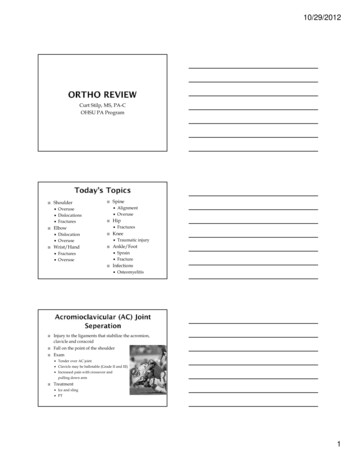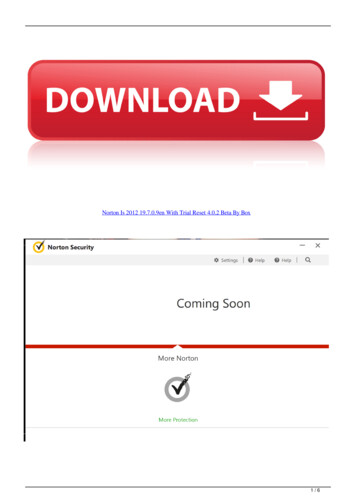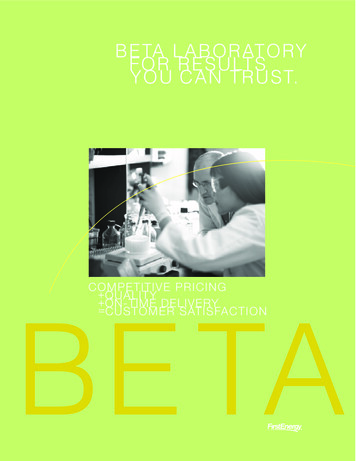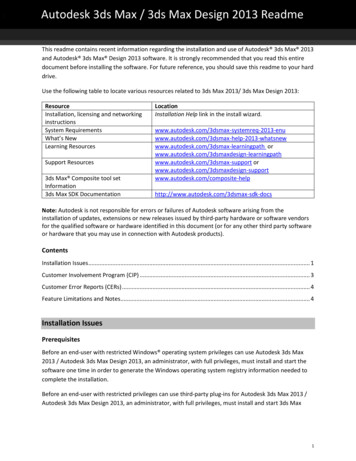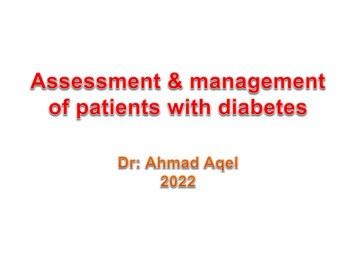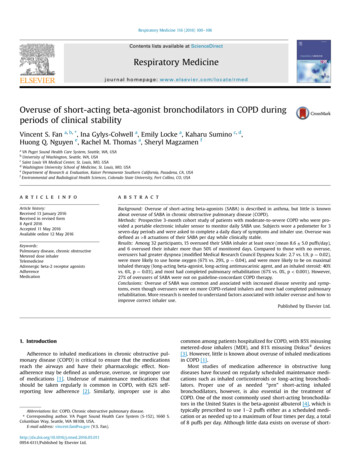
Transcription
Respiratory Medicine 116 (2016) 100e106Contents lists available at ScienceDirectRespiratory Medicinejournal homepage: www.elsevier.com/locate/rmedOveruse of short-acting beta-agonist bronchodilators in COPD duringperiods of clinical stabilityVincent S. Fan a, b, *, Ina Gylys-Colwell a, Emily Locke a, Kaharu Sumino c, d,Huong Q. Nguyen e, Rachel M. Thomas a, Sheryl Magzamen faVA Puget Sound Health Care System, Seattle, WA, USAUniversity of Washington, Seattle, WA, USASaint Louis VA Medical Center, St. Louis, MO, USAdWashington University School of Medicine, St. Louis, MO, USAeDepartment of Research & Evaluation, Kaiser Permanente Southern California, Pasadena, CA, USAfEnvironmental and Radiological Health Sciences, Colorado State University, Fort Collins, CO, USAbca r t i c l e i n f oa b s t r a c tArticle history:Received 13 January 2016Received in revised form8 April 2016Accepted 11 May 2016Available online 12 May 2016Background: Overuse of short-acting beta-agonists (SABA) is described in asthma, but little is knownabout overuse of SABA in chronic obstructive pulmonary disease (COPD).Methods: Prospective 3-month cohort study of patients with moderate-to-severe COPD who were provided a portable electronic inhaler sensor to monitor daily SABA use. Subjects wore a pedometer for 3seven-day periods and were asked to complete a daily diary of symptoms and inhaler use. Overuse wasdefined as 8 actuations of their SABA per day while clinically stable.Results: Among 32 participants, 15 overused their SABA inhaler at least once (mean 8.6 5.0 puffs/day),and 6 overused their inhaler more than 50% of monitored days. Compared to those with no overuse,overusers had greater dyspnea (modified Medical Research Council Dyspnea Scale: 2.7 vs. 1.9, p ¼ 0.02),were more likely to use home oxygen (67% vs. 29%, p ¼ 0.04), and were more likely to be on maximalinhaled therapy (long-acting beta-agonist, long-acting antimuscarinic agent, and an inhaled steroid: 40%vs. 6%, p ¼ 0.03), and most had completed pulmonary rehabilitation (67% vs. 0%, p 0.001). However,27% of overusers of SABA were not on guideline-concordant COPD therapy.Conclusions: Overuse of SABA was common and associated with increased disease severity and symptoms, even though overusers were on more COPD-related inhalers and more had completed pulmonaryrehabilitation. More research is needed to understand factors associated with inhaler overuse and how toimprove correct inhaler use.Published by Elsevier Ltd.Keywords:Pulmonary disease, chronic obstructiveMetered dose inhalerTelemedicineAdrenergic beta-2 receptor agonistsAdherenceMedication1. IntroductionAdherence to inhaled medications in chronic obstructive pulmonary disease (COPD) is critical to ensure that the medicationsreach the airways and have their pharmacologic effect. Nonadherence may be defined as underuse, overuse, or improper useof medications [1]. Underuse of maintenance medications thatshould be taken regularly is common in COPD, with 62% selfreporting low adherence [2]. Similarly, improper use is alsoAbbreviations list: COPD, Chronic obstructive pulmonary disease.* Corresponding author. VA Puget Sound Health Care System (S-152), 1660 S.Columbian Way, Seattle, WA 98108, USA.E-mail address: vincent.fan@va.gov (V.S. 954-6111/Published by Elsevier Ltd.common among patients hospitalized for COPD, with 85% misusingmetered-dose inhalers (MDI), and 81% misusing Diskus devices[3]. However, little is known about overuse of inhaled medicationsin COPD [1].Most studies of medication adherence in obstructive lungdiseases have focused on regularly scheduled maintenance medications such as inhaled corticosteroids or long-acting bronchodilators. Proper use of as needed “prn” short-acting inhaledbronchodilators, however, is also essential in the treatment ofCOPD. One of the most commonly used short-acting bronchodilators in the United States is the beta-agonist albuterol [4], which istypically prescribed to use 1e2 puffs either as a scheduled medication or as needed up to a maximum of four times per day, a totalof 8 puffs per day. Although little data exists on overuse of short-
V.S. Fan et al. / Respiratory Medicine 116 (2016) 100e106acting beta-agonists (SABA) use in COPD, data from a randomizedclinical trial of asthma treatment found that 27% of patients had atleast one episode of extreme beta-agonist overuse, defined as 20puffs of budesonide-formoterol, or 32 actuations of salbutamol, inany 24 h period [5]. This raises the possibility of similar overuse inCOPD.Overuse of SABA may contribute to known adverse side-effects,including tachycardia, vasodilation, transient hypoxemia, hyperglycemia, hypokalemia, tachyarrythmias, and tremor [4]. Althoughcardiovascular effects are generally considered mild, new users ofbeta-agonists may be at increased risk of myocardial infarction [6].Assessment of medication adherence in COPD is generally doneusing self-report, which tends to overestimate adherence, and doesnot generally measure overuse [1]. Increasing availability of electronic inhaler monitoring devices may allow more accurate measurement of inhaler use, and identify patients with both suboptimaluse and overuse [7].The primary aim of this study was to examine whether overuseof SABA occurs during periods of clinical stability in patients withCOPD, and the factors associated with overuse. In addition, weexamined whether there was agreement between daily selfreported inhaler use and inhaler use detected by electronicmonitoring.2. Materials and methodsThe data for this analysis were obtained from a prospective,observational cohort study of ambulatory patients with COPD at theVA Puget Sound Health Care System in Seattle, WA. This was a pilotstudy to examine the feasibility of measuring the timing andlocation of SABA inhaler use, development of worsening symptomsand exacerbations, air pollution, and physical activity patterns. Thisstudy was reviewed by the VA Puget Sound Health Care CenterInstitutional Review Board (ID: 00408); all subjects providedinformed consent.Eligibility criteria included: 1) COPD diagnosis, 2) FEV1/FVC 0.70 with a FEV1% predicted 80%, 2) use of an SABA inhaler, 3) 10 pack-year smoking history but not currently smoking, 4) age 40, 5) a resident of King or Pierce Counties in Washington State(regions with air pollution monitors), 6) no exacerbations in thefour weeks prior to enrollment. Exclusion criteria included: 1)clinical diagnosis of asthma, 2) subjects needing assistance inwalking, and 3) a modified Medical Research Council (mMRC)dyspnea score of 4 (“too breathless to leave the house or breathlesswhen dressing”).At baseline, subjects performed spirometry and completedquestionnaires including the UCSD Shortness of Breath Questionnaire (SOBQ) [8] and the Chronic Respiratory Questionnaire (CRQ),a COPD-specific health-related quality of life instrument with foursubscales (Mastery, Emotional Function, Fatigue, and Dyspnea) [9].At baseline participants also completed questionnaires regardingdemographic characteristics, and alcohol use measured with theAUDIT-C [10]. Participants were classified into a combined GOLDcategory which is determined by an assessment of the mMRC,exacerbation history, and FEV1 [11]. During the 3-month follow-upperiod, participants completed monthly interviews (either inperson or by telephone) during which they again completed theSOBQ and CRQ measures. On the monthly phone calls, the coordinator ascertained exacerbation symptoms, treatment, and healthcare utilization using a standardized questionnaire. A COPD exacerbation was defined as a new onset or increase in at least onerespiratory symptoms (cough, sputum, wheezing, dyspnea, or chesttightness) lasting 2 days.Subjects were given a waist-mounted Omron HJ-720ITCpedometer, shown to be accurate in COPD [12], to wear for three101seven-day periods corresponding roughly to each month of thestudy. At their final visit, subjects completed a survey indicatingtheir satisfaction with the inhaler sensor and pedometer used inthe study.2.1. Inhaler sensorSubjects were provided a portable electronic inhaler sensor(Propeller Health, Madison, WI) to monitor their SABA use duringthe course of the study [13]. With the exception of the first threesubjects enrolled in the study, who used an earlier model [13], allstudy subjects used an inhaler sensor mounted to the top of theSABA metered dose inhaler (MDI) canister that was automaticallypaired wirelessly to a smartphone using secure, low-power, Bluetooth technology. Subjects were provided a smartphone by thestudy which was used to communicate the inhaler use informationto the system servers. If the smartphone was not in physical rangewhen an inhaler was used, the sensor stored the details in memory(which can hold approximately 3900 events) and transmitted theinformation when it was eventually paired with the smartphone.Research staff tracked inhaler use and sensor battery life foreach subject using a secure website. Participants in this study didnot have access to the smartphone applications and websites, andcould not view the data being collected. All personal health information associated with the Propeller application was encryptedaccording to The Health Insurance Portability and AccountabilityAct.Since this was an observational, non-intervention study, allparticipants were instructed to continue all of their prescribedCOPD medications as directed by their care provider, includingtheir SABA inhaler. Study staff did not make any recommendationsto participants on how often to use their SABA inhaler. We asked allparticipants about their COPD medications that they were prescribed. We abstracted prescriptions from the medical record todetermine whether the SABA inhaler was prescribed “as needed” oras a “fixed dose” combined with as needed SABA.2.2. Daily COPD diaryAll subjects were given a calendar to use for the three monthfollow-up period and asked to record the number of inhaler actuations per day, changes in COPD symptoms, and treatment for exacerbations including medications and health care utilization. Themain purpose of this diary was to improve recall during themonthly phone calls with study staff. We used the followingquestion from the diary to examine concordance between patientself-reported and inhaler sensor measured daily inhaler use: “Sinceyesterday morning, how many inhalations of your rescue medication have you used?”2.3. Statistical analysisWe analyzed days during which participants were clinicallystable and did not report symptoms of a COPD exacerbation. Weexcluded the first and last days of the study since these were notfull days of participation. This version of the inhaler sensor used inthis study did not allow us to determine whether a day with norecorded puffs was a day when the participant did not use theirSABA inhaler, or if it was a day when the sensor was not charged orturned off. To better understand the missing sensor data, we useddata from 9 participants who completed the diary and also hadmissing sensor data. We found that nearly all participants selfreported using their SABA inhaler on missing sensor days, andtherefore we excluded days when no puffs were recorded sinceimputing those days as 0 would likely be inaccurate.
102V.S. Fan et al. / Respiratory Medicine 116 (2016) 100e106Table 1Self-reported SABA use among participants who completed the diary on days withmissing sensor data.ID# days missing sensor data1245678931585284415418Self-reported SABA use for days withmissing sensor dataMean(SD)MinMax4.00.34.03.12.03.93.02.1( 0.2)( 0.7)( 0.0)( 0.4)( 0.0)( 0.5)( 0.0)( 0.3)4042223253442433We defined overuse of SABA inhaler by participants as 8 actuations recorded by the inhaler sensor on any non-exacerbationday during the 3 month follow-up period. We also defined a category of extreme overuses as those who used 8 puffs for 50% ofobserved days during the follow-up period.The comparison between diary vs monitor puffs per day wasassessed using correlation coefficients calculated for repeatedmeasures [14,15]. The relationships were described using two correlation coefficients, one for “between subjects” and one for“within subjects”. The “between subjects” correlation examineswhether participants with a higher self-reported inhaler use alsotend to have high inhaler use measured with the electronic sensor[15]. The “within subject” correlation examines whether an increase in self-reported inhaler use within the same participant isassociated with increased electronically monitored inhaler use andassumes that each subject had the same slope to ensure that thecorrelation reflected change within, rather than between a subject[14].3. ResultsBetween December 2011 and January 2014, 35 subjects enrolledin the study. All participants were prescribed albuterol as theirTable 2Baseline characteristics, by SABA overuse during clinical stability.SABA use 8 puffs per dayp-valuen(%) or mean(SD)DemographicsAgeGender, maleRace, non-CaucasianLives aloneMarriedIncome, 20,000Employment, disabledEducation, high school graduate or lessUnhealthy alcohol useaSmoking, pack-yearsBMIEnrollment seasonWinter/SpringSummer/FallDisease severityExacerbations in the last yearFEV1 (% predicted)Modified Medical Research Council (mMRC)dyspnea scorebGOLDABCDComorbid illnessHeart diseaseHeart failureAtrial fibrillationDepressionAnxietyDrug abuseSymptoms, QOL, Physical ActivityShortness of Breath Questionnaire (SOBQ)bChronic Respiratory Questionnaire (CRQ)cDyspnea domainFatigue domainEmotional domainMastery domainPhysical Activity Scale for the Elderly (PASE)cPedometer, steps/dayP-value based on Fischer’s exact, c2, or t-tests.aAUDIT-C score 3 for women and 4 for men [16e18].bHigher score ¼ worse SOB; ranges mMRC 0e4, SOBQ 0-120.cHigher score ¼ better health; ranges CRQ domains 1e7, PASE 0e400þ.No overuseOveruseN ¼ 17N ¼ (47.6)2861(2099)0.320.340.650.290.670.07
V.S. Fan et al. / Respiratory Medicine 116 (2016) 100e106SABA inhaler. Three subjects were removed from all analysisbecause they had 7 days of monitor data after excluding exacerbation days. Of the 32 remaining subjects, concurrent diary datawas available for 11 subjects. On average, each participant wasmissing sensor data for 22.8 ( 19.1) of non-exacerbation days. Tobetter understand whether these days were days of zero use oralternatively that the sensor was not charged or turned off, wecompared self-reported SABA use for the 9 participants whocompleted the diary and had missing sensor days in Table 1. Wefound that nearly all participants reported inhaler use on their diarywhen the sensor data was missing.The number of non-exacerbation days recorded with themonitor ranged from 12 to 89 per subject, for a total of 1535 days.Among all 32 participants, the daily mean inhaler use was 5.5( 4.5) puffs. For the 17 subjects who never overused their inhaler,the mean use was 2.7 ( 0.9) puffs per day. For the 15 who overusedtheir inhaler at least once, mean SABA use was 8.6 ( 5.0) puffs perday; six subjects had extreme overuse (overusing their inhalermore than 50% of days) with a mean use of 13.8 ( 3.4) puffs per day.Comparison of the baseline characteristics found that overuserswere more likely to be unemployed due to disability (47% vs. 12%,p ¼ 0.02), and to experience increased dyspnea (mMRC 2.7 vs. 1.9,p ¼ 0.02) (Table 2).Overusers were more likely to be GOLD categories B and D thanA or C (p ¼ 0.04) compared to non-overusers. Although not statistically significant, the SOBQ scores were worse in overusers (60.0vs. 46.5, p ¼ 0.08) than non-overusers. The overuse group had ahigher average pedometer steps/day (2861 vs. 1690, p ¼ 0.07) thanthe group which never overused their inhaler. Of note, there was nodifference in SABA use by season for participants enrolled in winterand spring compared to summer and fall (p ¼ 0.99).With regard to how SABA prescriptions were written by theirtreating provider, 20% of the 15 overusers had prescriptionsinstructing them to use their SABA as a “fixed” dose, compared to29% of the 17 subjects with no overuse (p ¼ 0.69) (Table 3). SABAoverusers were more likely to be using home oxygen (67% vs 29%,103p ¼ 0.04) and be prescribed a long-acting muscarinic agent (LAMA)medication (67% vs. 35%, p ¼ 0.08).Based on GOLD guidelines, there were no differences in theproportion of overusers and non-overusers receiving guidelineconcurrent inhaler therapy (73% vs. 76%, p ¼ 0.99), however, moreoverusers were on maximal inhaler therapy with combination of aLABA, a LAMA, and an inhaled steroid compared to non-overusers(40% vs. 6%, p ¼ 0.03). More overusers had completed pulmonaryrehabilitation, compared to those who never overused SABA (67%vs 0%, p 0.01).For the 11 participants who completed a daily diary recordingthe total number of SABA puffs per day, the number of diary dayscontributed by each participant ranged from 16 to 84 (Table 4).Two subjects, #6 and #8, wrote the identical number of puffs inthe diary for all days, even though their sensor recorded variabilityfrom day to day. The “within subject” correlation, which examineswhether an increase in self-reported inhaler use is associated withan increase in monitored SABA use within the same individual, wasr ¼ 0.32 (p 0.001). In Fig. 1, the self-report and sensor data serieswere superimposed to show inhaler use by type of monitoring andday for each subject. The sensor method range was 1e26 puffs/day;the self-report range was 0e18 puffs/days (0 puffs were reportedfor 5 days by subject #2).We used the “between subjects” correlation to examinewhether participants who tended to have high self-reported SABAuse also had high SABA use based on the inhaler sensor. Fig. 2 plotsthe means from Table 3, where the circle sizes represents thenumber of days which each subject contributed to the analysis. The“between subjects” correlation was 0.94 (p 0.001).4. ConclusionsWe found that nearly half of our sample of participants withCOPD overused their SABA inhaler at least once during threemonths of observation, with 19% overusing their SABA more thanhalf of the days. The overusers had evidence of more severe COPDTable 3COPD treatments by those who overuse SABA compared to those with no SABA overuse during periods of clinical stability.n(%) or mean(sd)Comparison of no overuse to any overusebPuffs per daySABA prescription instructions“fixed” use“as needed” (PRN) useMedication therapyInhaled CorticosteroidLong-acting b-agonistLong-acting anticholinergicShort-acting anticholinergicNebulizer, SABANebulizer, IpratropiumTheophyllineChronic prednisoneMaximal therapyeGuideline concurrent therapyfPulmonary rehabilitationHome oxygen useaComparison of no overuse to some or extreme overusep-valuecSome overuseExtreme 30.99 0.400.400.130.990.290.750.690.640.040.75 0.010.06No overuseAny overuseN ¼ 17N ¼ 152.7(0.9)8.6(5.0) 6(40%)11(73%)10(67%)10(67%)P-values based on Fischer’s exact, ANOVA, or t-test.aAny overuse: 8 puffs for at least one day; Extreme overuse 8 puffs for 50% of monitored days.bNon-exacerbation days.cp-value comparing no overuse to any overuse.dp-value comparing no, some, or extreme overuse.eUsing inhaled corticosteroid, long-acting beta-agonist, and long-acting muscarinic agent together.fFirst-line therapy, based on GOLD pocket guide.p-valued 0.01
104V.S. Fan et al. / Respiratory Medicine 116 (2016) 100e106Table 4SABA Use during Clinical Stability: Comparison of Electronic Monitor vs Diary.Subject #DaysaSABA puffs per day, by COPD 75556DiaryDifference of 00.70.00.30.71.64.1 1.3 0.2 2.2 0.1 1.22.1 0.61.7 0.12.41.70.1Correlations with repeated measures (Bland & Altman, 1995).Within subjects: r ¼ 0.32 p-value ¼ 0.001.Between subjects: r ¼ 0.94 p-value ¼ 0.001.aNumber of overlapping days between Diary and GPS monitor.bWeighted mean/SD for 11 subjects over 556 days.than non-overusers, and were more likely to be using home oxygentherapy and to have increased dyspnea. Despite this, more than 25%of participants were not prescribed GOLD-guideline concordantCOPD medications.It is unclear why so many participants in this study were overusing their as needed short-acting bronchodilator during periods ofclinical stability, and little is known in general about inhaler overuse in COPD [1]. A few studies have examined this phenomenon inasthma, and a study in New Zealand reported that 12% self-reported 8 puffs rescue inhaler use per day at baseline [5]. A studyof asthmatics in the US found that 15.8% of moderately or severelysymptomatic patients overused beta-agonists [19]. Factors associated with SABA overuse in that study include male gender, thosewith more asthma symptoms, on more asthma medications, difficulty getting medications for asthma, and prior hospitalizations,whereas those under the care of an allergist had a reduced risk of bagonist overuse. Our findings that overusers had more dyspnea,increased disability, and more COPD-related medications use areconsistent with the findings from asthma.The majority of overusers in our study were classified as GOLDcategory D, and according to the guidelines should receive a combination inhaled corticosteroid and LABA and/or a LAMA. Since only50% of extreme overusers were on combined maximal therapy withall three medications (inhaled steroids, LABA and/or a LAMA), it ispossible that maximizing therapy would help improve symptomsand decrease as-needed SABA use.Although we did not assess inhaler technique in our study,inadequate technique may contribute to overuse if patients do notreceive an adequate dose of medications with each inhalation. Upto 80% of COPD patients do not use their inhalers correctly [3], aFig. 1. SABA puffs per day for 11 subjects, Electronic Sensor vs Diary.
V.S. Fan et al. / Respiratory Medicine 116 (2016) 100e106105Fig. 2. Mean SABA puffs per day for 11 subjects, Electronic Sensor vs Diary.third of patients have never received instructions on inhaler use[20], and up to 69% of patients state that their provider has neverobserved them using their inhalers [21]. Providers may also not befamiliar with how to use the inhaler devices [22]. Although 67% ofthe overusers in our sample had completed a pulmonary rehabilitation program, guidelines recommend ongoing, regular assessment of inhaler technique at clinic visits and on discharge from thehospital after an exacerbation [23].SABA medications have several side-effects including tremor,palpitations, increased blood glucose levels, decreased blood oxygen levels, hypokalemia, and may result in tachyphylaxis [4]. Theremay be cardiac side effects including myocardial infarction andheart failure, particularly among those with underlying cardiacdisease [24]. Given the high prevalence of beta-agonist overuse inour sample, understanding why patients overuse their inhalers andefforts to decrease b-agonist overuse should be considered.Interestingly, participants who overused their inhalers tendedto walk more, despite having more severe disease. Although notstatistically significant (p ¼ 0.07), overusers walked 69% more stepsper day than those who never overused. This raises the possibilitythat overusers rely on their SABA inhaler to allow them to walkmore. In fact, 67% of overusers had participated in pulmonaryrehabilitation, compared to 0% of those who never overused, andthese patients may have learned to cope with dyspnea during activities by using their SABA inhaler more often with physical activity. Future interventions focused on maximizing maintenanceinhalers or teaching breathing techniques may reduce COPD patients’ dependence on SABA use. Our results differ from a study ofCOPD patients in Finland where questionnaire-based measurementof physical activity and pharmacy refill-based assessment of inhaleruse found that physically active patients had less cumulative SABAuse [25]. The difference between their study and ours may be due tothe fact that we objectively measured physical activity and inhaleruse on a daily basis and were able to exclude days during whichsubjects experienced an exacerbation.Only one third of these study participants completed the writtendiary, and it is known that pen and paper diaries may often beimprecise, including untimely and inaccurate entries [26,27]. Wefound that two subjects entered the same value for self-reportedinhaler use for the entire observation period, further suggestingpatient self-report entry is unreliable. In addition when analyzingthe 11 participants with both electronic and paper diary data, wefound only modest correlation (r ¼ 0.32) within individual participants. The “between” subject correlation was much higher(r ¼ 0.94), consistent with the fact that in general subjects withhigh SABA use measured with the sensor also had high use by dailydiary. Therefore, to obtain reliable data, electronic monitoring islikely a better choice since the electronic sensor more accuratelyreflects day-to-day variation in inhaler use and is preferred bystudy subjects [26]. Electronically monitored medication use canalso be transmitted to health care providers to help with COPDmanagement.This study has several potential limitations. Due to the smallsample size, the results are exploratory and we were not able todevelop multivariable models to examine the factors associatedwith overuse. These results will therefore need to be confirmed in
106V.S. Fan et al. / Respiratory Medicine 116 (2016) 100e106studies with larger sample sizes. In addition, the small sample sizemay have limited the statistical power to detect associations between patient characteristics and SABA overuse. The diary wasencouraged to be completed daily by all patients, but was onlycompleted by one third of the participants. It is also possible thatparticipants did not self-report each actuation of SABA if they usedmore than one puff at a given time. The two early versions of theelectronic inhaler sensor we used for this study did not allow us todetermine whether a result of zero actuations measured by theelectronic monitor was due to the patient not using the inhaler ordue to the sensor not being turned on, although this issue is lesslikely to affect classification of overusers.In conclusion, we found that nearly half of the COPD patientsoverused their as-needed SABA inhaler during the 3 monthobservation period and that overuse was associated with greaterdisease severity and more dyspnea. Although overusers had greateruse of COPD medications, many were not on GOLD-guideline concurrent therapy. Future studies should address reasons for overuse,and whether interventions may reduce overuse while improvingrespiratory symptoms.Conflict of interest statementDr. Fan reports grants from the Veterans Affairs and the NationalInstitutes of Health during the conduct of the study. Dr. Nguyenreports grants from the National Institutes of Health and PatientCentered Outcomes Research Institute during the conduct of thestudy. Dr. Sumino, Dr. Magzamen, Rachel Thomas, Emily Locke, andIna Gylys-Colwell have nothing to declare.DisclaimerThe views expressed in this article are those of the authors anddo not necessarily reflect the position or policy of the Departmentof Veterans Affairs or the United States Government.AcknowledgementsHong T.K. Nguyen and Carol Simons participated in recruitment,data collection and data management for the study. Leslie Taylorand Eric Gunnink assisted with data analysis and assistance withplots. This research was supported by grant from the United StatesDepartment of Veterans Affairs Health Services Research andDevelopment (VA HSR&D PPO 10-299) Program.References[1] R.D. Restrepo, M.T. Alvarez, L.D. Wittnebel, et al., Medication adherence issuesin patients treated for COPD, Int. J. Chron. Obstruct Pulmon Dis. 3 (3) (2008)371e384.[2] J. George, D.C. Kong, R. Thoman, K. Stewart, Factors associated with medication nonadherence in patients with COPD, Chest 128 (5) (2005) 3198e3204.[3] V.G. Press, V.M. Arora, L.M. Shah, et al., Misuse of respiratory inhalers inhospitalized patients with asthma or COPD, J. Gen. Intern Med. 26 (6) (2011)635e642.[4] M. Cazzola, C.P. Page, P. Rogliani, M.G. Matera, beta2-agonist therapy in lungdisease, Am. J. Respir. Crit. Care Med. 187 (7) (2013) 690e696.[5] M. Patel, J. Pilcher, H.K. Reddel, et al., Predictors of severe exacerbations, poorasthma control, and beta-agonist overuse for patients with asthma, J. allergyClin. Immunol. Pract. 2 (6) (2014) 751e758 e751.[6] D.H. Au, J.R. Curtis, N.R. Every, M.B. McDonell, S.D. Fihn, Association betweeninhaled beta-agonists and the risk of unstable angina and myocardial infarction, Chest 121 (3) (2002) 846e851.[7] M. Patel, K. Perrin, A. Pritchard, et al., Accuracy of patient self-report as ameasure of inhaled asthma medication use, Respirology 18 (3) (2013)546e552.[8] E.G. Eak
Background: Overuse of short-acting beta-agonists (SABA) is described in asthma, but little is known about overuse of SABA in chronic obstructive pulmonary disease (COPD). Methods: Prospective 3-month cohort study of patients with moderate-to-severe COPD who were pro-vided a portable electronic inhaler sensor to monitor daily SABA use.
